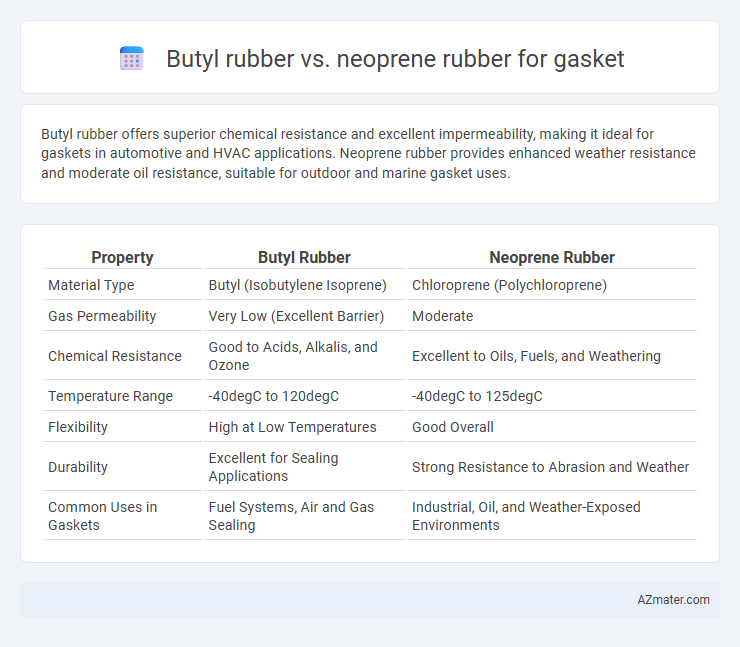Butyl rubber offers superior chemical resistance and excellent impermeability, making it ideal for gaskets in automotive and HVAC applications. Neoprene rubber provides enhanced weather resistance and moderate oil resistance, suitable for outdoor and marine gasket uses.
Table of Comparison
| Property | Butyl Rubber | Neoprene Rubber |
|---|---|---|
| Material Type | Butyl (Isobutylene Isoprene) | Chloroprene (Polychloroprene) |
| Gas Permeability | Very Low (Excellent Barrier) | Moderate |
| Chemical Resistance | Good to Acids, Alkalis, and Ozone | Excellent to Oils, Fuels, and Weathering |
| Temperature Range | -40degC to 120degC | -40degC to 125degC |
| Flexibility | High at Low Temperatures | Good Overall |
| Durability | Excellent for Sealing Applications | Strong Resistance to Abrasion and Weather |
| Common Uses in Gaskets | Fuel Systems, Air and Gas Sealing | Industrial, Oil, and Weather-Exposed Environments |
Introduction to Butyl and Neoprene Rubber Gaskets
Butyl rubber gaskets are known for their excellent impermeability to gases and resistance to chemicals, making them ideal for sealing applications in automotive and HVAC systems. Neoprene rubber gaskets offer superior weather resistance, oil tolerance, and mechanical strength, commonly used in marine environments and industrial machinery. Both materials provide durable sealing solutions but are selected based on specific environmental and chemical exposure requirements.
Chemical Composition and Structure Comparison
Butyl rubber features a copolymer of isobutylene with a small amount of isoprene, resulting in a saturated hydrocarbon backbone that provides excellent impermeability and chemical resistance to gases and acids. Neoprene rubber, or polychloroprene, is a chlorinated polymer derived from chloroprene, offering moderate chemical stability with enhanced resistance to oils, ozone, and weathering due to the presence of chlorine atoms in its structure. The molecular structures influence gasket performance, with Butyl's saturated backbone yielding superior resistance to polar chemicals and Neoprene's chlorine content improving durability against oils and environmental degradation.
Key Physical Properties: Butyl vs Neoprene
Butyl rubber offers superior impermeability to gases and excellent resistance to weathering, making it ideal for gaskets exposed to air and moisture. Neoprene rubber provides better resistance to oils, chemicals, and moderate heat, suitable for gaskets in industrial environments. Key physical properties highlight butyl's high elasticity and low permeability, while neoprene excels in tensile strength and chemical stability.
Temperature Resistance Differences
Butyl rubber offers excellent resistance to temperatures ranging from -50degC to 120degC, making it ideal for applications requiring flexibility in low-temperature environments. Neoprene rubber withstands a broader temperature range, typically from -40degC up to 130degC, providing better performance in moderately high-heat conditions. The temperature resistance difference makes neoprene more suitable for gaskets exposed to higher thermal stress, while butyl rubber excels in sealing against gases and moisture at lower temperatures.
Chemical and Oil Resistance
Butyl rubber offers excellent resistance to polar solvents, acids, and alkalis, making it ideal for gasket applications exposed to harsh chemicals. Neoprene rubber excels in resistance to oils, greases, and moderate acids, providing superior durability in petroleum-based environments. For gasket selection, butyl is preferred in chemical processing, while neoprene suits oil and lubricant sealing due to their respective resistance profiles.
Durability and Longevity
Butyl rubber offers exceptional resistance to weathering, ozone, and chemicals, making it highly durable for gasket applications exposed to harsh environmental conditions. Neoprene rubber provides excellent aging stability and resistance to oils, oils, and temperature variations, enhancing gasket longevity in dynamic environments. Both materials deliver robust sealing performance, but Butyl rubber typically outperforms Neoprene in extended outdoor durability and chemical resistance.
Cost Analysis and Economical Use
Butyl rubber offers superior chemical resistance and excellent air impermeability, making it cost-effective for gaskets exposed to harsh chemicals or requiring airtight seals, despite a slightly higher initial price compared to neoprene. Neoprene rubber, with its balanced durability and moderate resistance to oils and weathering, provides a more economical choice for general-purpose gasket applications where extreme chemical resistance is not critical. Evaluating long-term performance and replacement frequency is crucial, as butyl's longevity can reduce total lifecycle costs, offsetting its upfront expense.
Typical Applications for Butyl Rubber Gaskets
Butyl rubber gaskets are commonly used in pharmaceutical, medical, and food processing industries due to their excellent impermeability to gases and resistance to chemicals and moisture. They provide superior sealing in applications requiring air and moisture barriers, such as sealing jars, bottles, and pharmaceutical closures. Neoprene rubber, while versatile and oil-resistant, is less ideal for high-purity or sensitive environments compared to butyl rubber.
Typical Applications for Neoprene Rubber Gaskets
Neoprene rubber gaskets are widely used in automotive, industrial, and marine applications due to their excellent resistance to weathering, oils, and chemicals. These gaskets provide effective sealing in refrigeration systems, HVAC units, and fuel handling equipment, ensuring durability and leak prevention. Their versatility in sealing against moderate heat and ozone exposure makes them ideal for outdoor and mechanical environments where resilience is critical.
Choosing the Right Rubber Gasket Material
Butyl rubber offers superior resistance to gases, moisture, and aging, making it ideal for airtight seals in automotive and HVAC gaskets. Neoprene rubber provides excellent oil, chemical, and weather resistance, suitable for outdoor and industrial gasket applications. Selecting the right gasket material depends on environmental exposure, chemical compatibility, and required durability in the specific sealing application.

Infographic: Butyl rubber vs Neoprene rubber for Gasket
 azmater.com
azmater.com